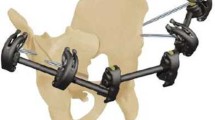Summary.
Open pelvic fractures are rare and account for 1–5 % of all pelvic fractures. Mortality rates of 50 % and even more have been reported. Bleeding and septic complications are the major causes of death. In our retrospective study from 1974 to 1996 the data of 40 patients were analyzed. Five patients died (12.5 %); 28 survivors could be investigated with a mean follow-up of 10 years. It is concluded that the comparably low mortality rate is due to a standardized treatment protocol. The main principles of management are emergency stabilization of the unstable pelvis and early laparotomy.
Zusammenfassung.
Offene Beckenfrakturen sind selten, gehen aber aufgrund pelviner und extrapelviner Begleitverletzungen mit einer hohen Letalität von bis zu 50 % und mehr einher. Haupttodesursachen sind der hämorrhagische Schock sowie septische Komplikationen. In einer retrospektiven Analyse wird der Verlauf bei 40 Patienten des Zeitraums 1974–1996 vorgestellt. Fünf Patienten starben (12,5 %), 28 Überlebende konnten nach durchschnittlich 10 Jahren nachuntersucht werden. Die vergleichsweise niedrige Letalität führen wir auf ein standardisiertes Behandlungskonzept zurück. Dabei spielt neben der Notfallstabilisierung des Beckens die frühzeitige Laparotomie die entscheidende Rolle.
Similar content being viewed by others
Author information
Authors and Affiliations
Rights and permissions
About this article
Cite this article
Rieger, H., Winde, G., Brug, E. et al. Die offene Beckenfraktur – eine Indikation zur Laparotomie?. Chirurg 69, 278–283 (1998). https://doi.org/10.1007/s001040050413
Issue Date:
DOI: https://doi.org/10.1007/s001040050413




